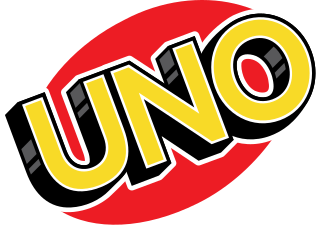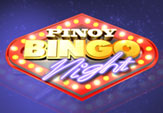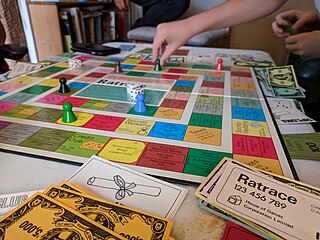Related Research Articles

Texas hold 'em is one of the most popular variants of the card game of poker. Two cards, known as hole cards, are dealt face down to each player, and then five community cards are dealt face up in three stages. The stages consist of a series of three cards, later an additional single card, and a final card. Each player seeks the best five card poker hand from any combination of the seven cards; the five community cards and their two hole cards. Players have betting options to check, call, raise, or fold. Rounds of betting take place before the flop is dealt and after each subsequent deal. The player who has the best hand and has not folded by the end of all betting rounds wins all of the money bet for the hand, known as the pot. In certain situations, a "split-pot" or "tie" can occur when two players have hands of equivalent value. This is also called a "chop-pot". Texas hold 'em is also the H game featured in HORSE and in HOSE.

Uno, stylized as UNO, is an American shedding-type card game originally developed in 1971 by Merle Robbins in Reading, Ohio, a suburb of Cincinnati, that housed International Games Inc., a gaming company acquired by Mattel on January 23, 1992.

Pit is a fast-paced card game for three to eight players, designed to simulate open outcry bidding for commodities. The game first went on sale in 1904 by the American games company Parker Brothers, having been developed by the clairvoyant Edgar Cayce.
Concentration is an American television game show based on the children's memory game of the same name. It was created by Jack Barry and Dan Enright. The show featured contestants matching prizes represented by spaces on a game board, which would then reveal portions of a rebus puzzle underneath for the contestants to solve.

Escape from Colditz is a board game produced by Gibsons Games of London in 1973 that simulates attempted escapes by Allied prisoners-of-war (POWs) from Oflag IV-C during World War II. Designed in part by a former POW who escaped from Colditz, the game was released during the first run of the popular television series Colditz, and the game likewise proved popular. Licensed editions were published by Parker Brothers and a number of other companies. The game proved especially popular in Spain, and resulted in a Spanish-language sequel.

Rackets or racquets is an indoor racket sport played in the United Kingdom, United States, and Canada. The sport is infrequently called "hard rackets", to distinguish it from the related sport of squash.
The Italian-American Civil Rights League (IACRL) was originally formed as a political advocacy group created in New York City in April 1970. William Santoro, a defense attorney that represented many Colombo crime family figures, was responsible for the legal work that incorporated the league. Its stated goal was to combat pejorative stereotypes about Italian-Americans, but in actuality, it operated as a public relations firm to deny the existence of the American Mafia and improve the image of mobsters.

The Godfather is a 2006 open world action-adventure video game developed by EA Redwood Shores and published by Electronic Arts. It was originally released in March 2006 for Microsoft Windows, PlayStation 2, and Xbox. It was later released for the PlayStation Portable as The Godfather: Mob Wars, Xbox 360 as The Godfather, Wii as The Godfather: Blackhand Edition, and PlayStation 3 as The Godfather: The Don's Edition.
The following outline is provided as an overview of and topical guide to games and gaming:
In the late 19th and early 20th centuries, African-American organized crime emerged following the first and second large-scale migration of African-Americans from the South to major cities of the Northeast, Midwest, and later the West Coast. In many of these newly established communities and neighborhoods, criminal activities such as illegal gambling, speakeasies and bootlegging were seen in the post-World War I and Prohibition eras. Although the majority of these businesses in African-American neighborhoods were operated by African Americans, it is often unclear the extent to which these operations were run independently of the larger criminal organizations of the time.
The London Game is a British board game based on the London Underground in London, England.

Gangsters 2: Vendetta is a 2001 PC video game. It was developed by Hothouse Creations, with Eidos Interactive as publishers. Gangsters 2 was designed by both Peter Moreland and Rob Davies. The game is the sequel to Gangsters: Organized Crime, also published by Eidos. While the original game focused on a nameless character, the sequel tells the story of an aspiring gangster who seeks to take revenge on his father's murderers while carving out a place for himself in the final years of Prohibition.
Image is a trivia card game developed Henry Szwarce and published by 3M in 1971. The object of the game is to put together cards that represent a historical or fictional character.

Break the Bank is a game show created by Richard S. Kline. It aired in syndication from September 16, 1985 to June 20, 1986, with repeats airing until September 12. It was not related to two previous shows by the same name.

A game is a structured form of play, usually undertaken for entertainment or fun, and sometimes used as an educational tool. Many games are also considered to be work or art.

The Godfather II is a 2009 action-adventure game developed by EA Redwood Shores and published by Electronic Arts. It was released for Microsoft Windows, PlayStation 3, and Xbox 360 in April. Based on the 1974 film The Godfather Part II, it is the sequel to the 2006 game The Godfather, which was based on the 1972 film of the same name. Like the first game, The Godfather II follows a non-canon character, Dominic, who is initially the protégé and underboss of the original game's protagonist, Aldo Trapani. After Aldo is killed, Dominic is placed in charge of the Corleone family's operations in New York City and tasked with expanding the Corleone empire by taking out their rivals. Unlike the first game, which was primarily set in New York, the story also spans into Miami and Havana.
The following is a glossary of poker terms used in the card game of poker. It supplements the glossary of card game terms. Besides the terms listed here, there are thousands of common and uncommon poker slang terms. This is not intended to be a formal dictionary; precise usage details and multiple closely related senses are omitted here in favor of concise treatment of the basics.

Pinoy Bingo Night is the Philippine game show version of National Bingo Night, which premiered on the ABS-CBN from March 30 to June 26, 2009. It is hosted by Kris Aquino with Brod Pete as the "bingo caller" and Mel Feliciano as the "commissioner", who referees the playing studio audience.
Sleuth is a strategy deduction card game designed by Sid Sackson and published by 3M in 1971. It is a reimplementation of the 1967 game The Case of the Elusive Assassin without the game board. The object of the game is to deduce the identity of a missing gem by questioning other players and gathering evidence, similar to Cluedo.

Ratrace is a family economic board game designed by Alfons Rubbens and published by Waddingtons in 1967. Described as "the madcap game of social climbing," players attempt to acquire status and cash in order to make their way from Working Class to High Society and become the wealthiest player by the end of the game.
References
- 1 2 Van Gelder, Lawrence (1971-11-13). "Critics of 'Godfather Game' Are Making a Racket". The New York Times . p. 35. Retrieved 2023-04-28.
- 1 2 3 Pritchard, David (November 1972). "The Godfather Game". Games & Puzzles (7): 4–5 – via Internet Archive.
- 1 2 3 Campion, Martin (August 1972). "Criminal Conflict" (PDF). Moves (4): 18.
- ↑ Whitehill, Bruce (1992). Games: American Boxed Games and Their Makers, 1822-1992. Radnor, Pennsylvania: Homestead Book Company. p. 44. ISBN 9780870695834 – via Internet Archive.
- ↑ Scarpone, Desi (1995). Board Games (1st ed.). Atglen Pennsylvania: Schiffer Publishing. p. 25. ISBN 9780887407253 – via Internet Archive.
- ↑ Hynd, Noel (October 1972). "Are you a Capo or a Capon?". The Mobster Times (2): 20–21 – via Internet Archive.
- ↑ Scarpaci, Vincenza (2008). The Journey of the Italians in America. Pelican Publishing. p. 214. ISBN 9781455606832. Archived from the original on 2020-09-05. Retrieved 2020-01-04.